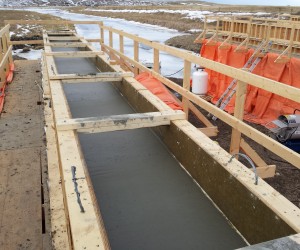Air entraining admixtures, as you can probably guess, force air into the concrete. They result in microscopic air bubbles spread relatively evenly throughout the concrete.
Reasons for Using Air Entraining Admixtures
There are several reasons to have air entrainment in concrete:
- To improve freeze-thaw resistivity
- To increase resistance to de-icing chemicals
- To enhance the workability of the concrete
Segregation and bleeding are virtually eliminated when using air entraining admixtures, although they are not usually the primary purpose of the admixture.
Specifications
Air entraining admixtures are governed by ASTM C260 and ASTM C233. The AASHTO equivalents are M154 and T157. Air entraining additions for use in the manufacture of air-entraining cements must meet the requirements of ASTM C226. Applicable requirements for air-entraining coments are given in ASTM C150 and AASHTO M85.
Materials
Air entraining admixtures contain one or more of the following chemicals:
- Salts of wood resins (Vinsol resin)
- Synthetic detergents
- Salts of sulfonated lignin
- Salts of petroleum acids
- Salts of proteinaceous material
- Fatty and resinous acids and their salts
- Alkylbenzene sulfonates
- Salts of sulfonated hydrocarbons

Speak Your Mind